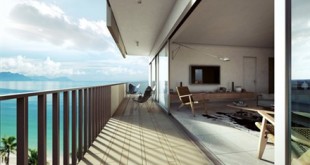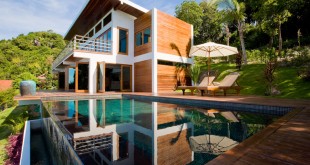Roger Lin’s push for low cost, high performance homes
By Suchi Rudra

Lin and his team chose to build an outdoor living space above the garage, a space that is usually the least comfortable room in the house–too hot in summer and too cold in winter. The green roof is not only an attractive area, but offers many benefits: very little maintenance once plants are established; plants and planters absorbs rain water which significantly reduces storm water from flowing into streets or neighbor’s yard; extends life of the roof by keeping the surface cooler.
These days, building a net zero energy home isn’t exactly a cutting edge idea. But what about an entire community of net zero homes, each moderately priced for the average consumer?

A typical home of this size (3,800 square feet) usually requires a 5-ton system, but thanks to the superinsulating and air-tight construction used in the Passivhaus approach, Lin and his team were able to reduce the heating and cooling loads for the house down to a 2-ton unit, which saves money on the equipment as well as its operation.
This is exactly what real estate investor and entrepreneur Roger Lin has in mind for the not too distant future. And already, Lin is well on his way to achieving his dream. In 2010, Lin and his brother Eric Lin, who co-founded Southern Exposure Homes in Fairfax, Va., turned many heads when they constructed the first Passivhaus home in Virginia.
Passivhaus (also known as Passive House), a design principle that aims for superior energy efficiency, is a growing interest in the region, according to Lin. His goal is not only to promote awareness of Passivhaus to builders and homeowners, but also to make its implementation more affordable in both new construction and retrofits.
Although Lin worked as a real estate attorney for four years, he dabbled fixing up old houses with his brother and eventually dove into the construction of new homes.
“We built a house in Arlington, sold it, and thought, ‘That was fun, let’s do it again.’ But you can’t just build another conventional house—there’s no reason to do that,” Lin says. Lin’s research into sustainable design led to the creation of another home with eco-friendly materials and energy efficient appliances, but Lin still felt the project to be only “lime-green”, and decided to zoom in on his real concern: energy consumption in the home.
“To change the way Americans live is to build homes at a reasonable cost with really great energy efficiency,” he says.
Driven by a strong desire to create a home that was “quantifiably green”, Lin decided to follow the more scientific approach of Passivhaus, which entails insulation values of at least 2 to 3 times higher than that of a conventional home.
Inspired by this idea of high performance homes, Lin and his brother built the well-renowned Passivhaus home in Arlington. After its completion, Lin decided to also work together with one of his subcontractors on the job, IntelliStructures, which provided Structural Insulated Panels (SIPs) for the Arlington home, a crucial material for high performance insulation. Lin saw that SIPs were slowly making inroads into conventional home building over the past 5 years, but knew he had to push for its application in constructing more energy efficient homes.
“How do I make this mainstream? That was my goal. People have this misconception that it costs more to use this material. But if you want to use SIPs for high performance, it’s actually cheaper than not using it for high performance. Typical framing design and technology is from 1930, and nothing has changed since then—it’s ridiculous. Building codes and energy codes are becoming stricter. Eventually it’s going to get to the point where if you want to comply to stricter codes, you’ll have to do a lot of patchwork to the existing design, and that’s going to become costly.”
As for affordability, the 3,800 square foot Passivhaus home was initially on the market for 1.25 million dollars (it is currently being leased to a family), which Lin says is on par with other custom homes of the same size in the region. But he adds that “once you figure out how to do it the first time, the second one is going to cost less”–and indeed, a second Passivhaus home is in the works for Lin and his team.
Meanwhile, Lin is excited about a deep energy retrofit of a 1970s townhouse, which was neglected for over 20 years. Lin hopes to turn the home into an inspiring example of superior quality and comfort on a modest budget.
“We are a much more educated population now, so why can’t we go beyond that 1970s construction and use a modest budget to create a house that’s comfortable, has high indoor air quality, high energy efficiency, is resilient and saves you money? I think people will soon start to understand that a quality renovation is not just about fancy flooring and spray foam insulation,” Lin says.
To further promote awareness of energy efficient design, Lin and his team are sponsoring and assisting the 2013 Washington, D.C. Decathlon team, and also sponsoring several builder trainings for the Department of Energy’s new Challenge Home building standard. The challenge, Lin explains, is to get builders to commit to constructing a certain number of high performance homes per year.
“It’s not Passivhaus, but it’s pretty close, and it’s a reasonable thing to do because Passivhaus can be kind of obsessive and crazy. In this region, we need something between the standard building code and Passivhaus, so Challenge Home is a good one.”
To find out more about Passivhaus and Intellistructures, visit Intellistructures.wordpress.com and arlingtonpassivehouse.wordpress.com
Asian Fortune is an English language newspaper for Asian American professionals in the Washington, DC metropolitan area. Visit fb.com/asianfortune to stay up to date with our news and what’s going on in the Asian American community.
 Asian Fortune Your source for all things Asian American
Asian Fortune Your source for all things Asian American



